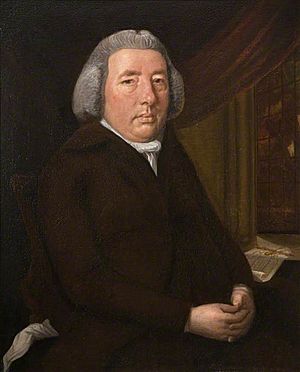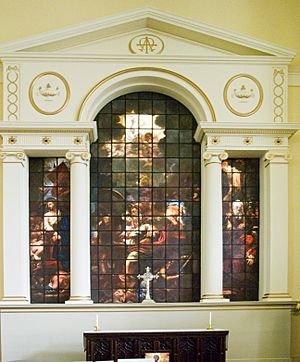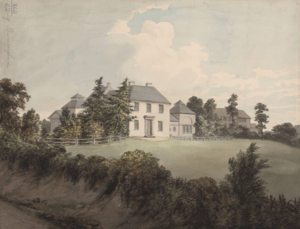Francis Eginton facts for kids
Quick facts for kids
Francis Eginton
|
|
|---|---|
 |
|
| Born | 1737 |
| Died | 1805 |
Francis Eginton (1737–1805) was an English artist who painted on glass. He is sometimes known as Egginton. He created beautiful stained glass windows for many important buildings across England, like cathedrals, churches, and grand homes. He made about 50 large artworks, and some of his glass paintings were even sent to other countries. His most famous work is The Conversion of St. Paul. You can see it in the east window of St Paul's Church, Birmingham. Francis Eginton also invented a special way to copy paintings using machines.
Contents
Early Life and Work
Francis Eginton's grandfather was a church leader. Francis learned how to work with enamel (a type of glass coating) in a town called Bilston.
When he was young, he worked for a famous businessman named Matthew Boulton at his factory, the Soho Manufactory. In 1764, Francis decorated items with a shiny finish called 'japanning'. He also spent a lot of time making models. Over the next few years, Boulton brought many talented artists to Soho. These included John Flaxman and James Wyatt. Francis quickly became skilled in many different types of decorative art.
Amazing "Mechanical Paintings"
Francis Eginton worked with Matthew Boulton to create "mechanical paintings" or "polygraphs". These were special copies of artworks. The idea for these paintings likely came from a process used by Robert Laurie. He had improved a method called 'aquatint' engraving.
Francis made the method even better. He used it to create colored copies of famous paintings. He needed more than one printing plate for each picture. After printing, Francis would finish them by hand. These copies were made from the works of artists like Philip James de Loutherbourg and Angelica Kauffman. They looked so real that people sometimes thought they were original paintings!
Bringing Glass Painting Back to Life
The part of Boulton's business that made these "mechanical paintings" was not making enough money. So, Francis Eginton and Matthew Boulton ended their partnership. Francis then decided to focus on painting on glass.
In 1784, he left the Soho factory and started his own business. He set up his workshop at Prospect Hill House. Before Francis Eginton, the art of painting on glass had almost disappeared. He brought it back to life! He created many beautiful stained glass works from his factory in Birmingham.
Some of his important glass paintings include:
- The coats of arms for the knights of the Garter at St. George's Chapel, Windsor.
- Windows for Salisbury Cathedral and Lichfield Cathedral. These were inspired by the artist Joshua Reynolds.
- A large picture of the "Good Samaritan" for the private chapel of the Archbishop of Armagh.
- Windows in many churches, such as Babworth Church, Aston Church in Birmingham, Shuckburgh Church, and Tewkesbury Abbey Church.
- The windows of Merton College chapel and the ante-chapel of Magdalen College in Oxford.
- The east window at St Paul's Church, Birmingham, which was a very important church to Matthew Boulton.
- The east window at St Alkmund's Church in Shrewsbury.
Francis also painted a huge window (20 feet by 10 feet) showing Solomon and the Queen of Sheba. This was for the dining hall at Arundel Castle. He also did a lot of work for William Beckford at Fonthill Abbey. This included 32 figures of kings and knights. He was paid a lot of money for this work, about £12,000. Many of his best works were sent to other countries, like Amsterdam.
In 1791, he finished what many thought was his best work: "The Conversion of St. Paul". This was for the east window of St Paul's Church, Birmingham. He was paid 400 guineas for this amazing piece.
Francis Eginton's artworks were like clear pictures on glass. His workshop was a popular place to visit for important people coming to Birmingham. Even Lord Nelson, a famous naval hero, visited his showroom in 1802.
Family Life
Francis Eginton's daughter married Henry Wyatt, who was also a painter. His son, William Raphael Eginton, took over his father's business. In 1816, William was chosen to be the glass-stainer for Princess Charlotte. Francis's brother, John Eginton, was a well-known engraver. His nephew, also named Francis Eginton, was also a talented engraver.
Francis Eginton passed away on March 26, 1805. He was buried in Old Handsworth churchyard.



